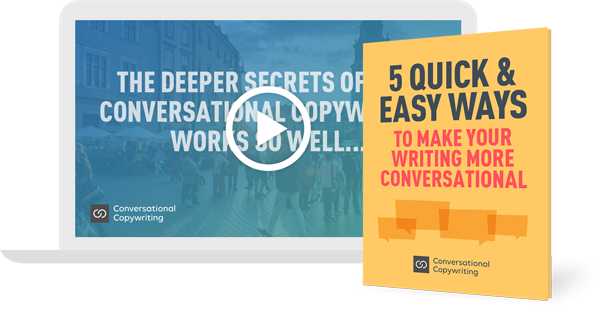
You think you’re having an open conversation with someone.
There’s some back and forth.
You have your say, and then he has his.
And then – dangit – you suddenly realize it’s one of THOSE conversations.
The other person isn’t really listening to you at all. He’s just waiting for the right moment to jump back in to push his own opinion.
While you’re talking, he’s essentially tuned out, marking time, and waiting for you to stop talking. He’s completely deaf to your side of the “conversation”.
Those are the really bad conversations.
And as copywriters, we can be just as tuned-out when we write sales pages and emails.
But before we get to that…
Let’s be clear about what we’re talking about when we talk about conversations.
There are actually three different types of conversations.
Type One: A simple exchange of information
You’re at the breakfast table, talking with your spouse, figuring out the things that need to be done that day. Take something out of the freezer for dinner. Pick up the dry cleaning. Take Lucy to her piano lesson. And so on.
It’s a conversation. But really just the sharing of information.
Type Two: An attempt to influence a behavior or outcome
You get to work and head off to a meeting with your boss. You want an increase in your department’s budget, so you can hire two more people.
It isn’t going to be an easy conversation. You’ll need to be at your “persuasive” best.
Whether at work or at home, these are the types of conversations where we are trying to influence an outcome in some way.
Type Three: A trust-based exchange that truly engages both sides
You meet up with a friend for a drink after work. You know each other well, trust each other completely and quickly become immersed in a deep conversation that actually turns into a learning experience for both of you.
By the time you look at your watch, you can’t believe how much time has passed. Oops… you’re late to pick up Lucy’s from her piano lesson!
These are the best types of conversations.
When lectures masquerade as conversations…
Most conversations contain elements from each of the three types.
We set out to exchange information. We try to be persuasive. And we attempt to build trust and engagement.
But all too often we find ourselves in those bad conversations, where the other person isn’t engaged with you at all, but is simply waiting to push his own agenda.
And let’s be honest here. It’s not always the other person who does this. We do it too. We all do it sometimes.
The same thing can happen when we write sales pages and emails.
As marketers, we are in the business of driving sales.
And when we’re doing that, we tap into all three of those conversational types.
We share information. We persuade. And hopefully, we engage with our audience and build trust.
That’s how it should be, and can be.
But we can also fall into “bad conversation” mode.
I imagine you know what I mean.
You read an email and it sounds amazingly conversational. It’s downright chatty. It’s written as if we were best friends…
But hang on… we’re NOT best friends.
You quickly realize that the email is simply pretending to be conversational.
It’s 100% persuasion, masquerading as being part of a conversation.
Take the first step in getting it right in your sales copy.
By all means, write in a way that is open and warm, right from the outset.
But don’t get ahead of yourself. Don’t pretend there’s a level of trust and engagement between you and your readers that doesn’t exist yet.
Because sooner or later they’ll figure it out…
They’ll realize this is one of those bad conversations. Yes, you sound all friendly and chatty, but really you’re just pushing your own agenda.
How can you change this dynamic?
Well, you could start by doing a little more listening!
Create some polls and surveys. Encourage and answer comments under blog posts. Do some live Q&A on Facebook. Engage more across all your social media channels.
I wrote about this in an earlier post… the various ways you can listen to and discover the language and priories of your audience.
And let people know you’re listening.
Let them know you’re engaged and aware of what they need and want from you.
Do that and you’ll find the tone of your copy begins to change.
Now your conversational approach will sound more authentic… because it is!
As a result, your audience will feel more engaged, they’ll trust you more, and they’ll be more likely to respond to your conversational approach.
Being conversational is a powerful sales tool.
Pretending to be conversational… not so much.
NOTE: If you’d like to add the craft of conversational copywriting to your online writer’s toolbox, find out about the Conversational Copywriting course here…

Nick, I’m embarrassed to confess that I’ve led more bad conversations than I can count.
To be fair to myself, though, I usually had a role that (I thought) required that I do a lot of lecturing, instructing, directing, criticizing, praising, and summarizing. Whenever I got feedback that others couldn’t get a word in edgewise, I’d try hard to be more “conversational” by being more friendly, softening my tone, complimenting people about trivial things, being humorous (compiling a storehouse of jokes) — but missing the point of conversation — an exchanging information through genuine engagement — entirely.